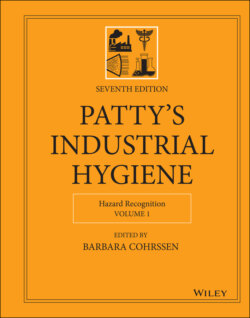Читать книгу Patty's Industrial Hygiene, Hazard Recognition - Группа авторов - Страница 107
2.1 Industrial Hygiene
ОглавлениеThe IH profession focuses on the anticipation, recognition, evaluation, and control of hazards that arise in the workplace that can affect the health of workers as well as the community at large. Therefore, the role of the IH in responding to emergencies arising from these workplace hazards and potentially affecting the greater public health is a natural extension of their professional responsibilities. However, the IH role in the identification of hazardous agents goes well beyond emergency response and is primarily focused on their responsibilities to protect the workers as they perform their tasks in a given workplace or across multiple facilities. The identification of potential hazards, the assessment of the work‐related risks, the establishing of the necessary controls, and the management of these risks over time for field IH practitioners span the broad scope of chemical, physical, and biological agents. As part of their assessment of work‐related health risks for a single task can include air sampling for an expanding array of potential chemical exposures, measuring for noise levels of nearby equipment, and acquiring an evaluation of mold spores to address indoor air quality issues. The broad array of professional knowledge to perform these assessments and identify commensurate controls is considered inherent to the extensive educational expectations that are necessary for the qualifications of a practicing IH. A qualified professional will have been given training across a broad cross‐section of scientific areas of expertise, including toxicology, epidemiology, statistics, microbiology, chemistry, physics, biology, engineering controls, monitoring equipment, and more.
An essential component that is often missing from professional IH curriculum is the basics of interpersonal relationships and the communication of their assessment outcomes to the workers they are ethically bound to protect. How does one communicate information derived from white‐collar technical and scientific foundations to a blue‐collar worker? The IH is dedicated to the prevention of work‐related disease and illness that are invariably an outcome of chronic exposures that accumulate over many years or decades. Warning a worker that excessive noise exposures may adversely affect their hearing in the next 20 years if they do not use hearing protection can easily sound like a grandparent's precautionary tale if the message is not delivered correctly. What is the correct method to ensure a worker understands the necessity of consistently using controls related to their profession when the harm may not be immediate or readily apparent and the level of concern amongst their peers is low? This is the most challenging type of risk communication that is all too common for the IH. This drives the necessity of finding a strategy to help workers understand that they must take these risks seriously, often with hazards that are not viewed by the likely apathetic audience in the workplace as an issue or perhaps as a commonly accepted exposure relating to a given task or professional trade. The better‐understood hazards that do not pose a higher risk, which often sets in at a medium level of concern as their impact may be known and are still considered a long‐term issue, can make the IH's risk communication easier. However, emerging new technologies like nanomaterials can cause workers' concern because there is so much unknown about the hazards. Similarly, chemical constituents are continually updated at a pace too rapid to establish occupational exposure limits (OELs), so here too there is often an increased concern that can fill the vacuum of lacking information. The management of this type of risk communication is not common to the IH profession and emerging controversies that can spill out to local communities create difficult issues that the profession must also learn how to handle and discuss with relevant stakeholders (9).
